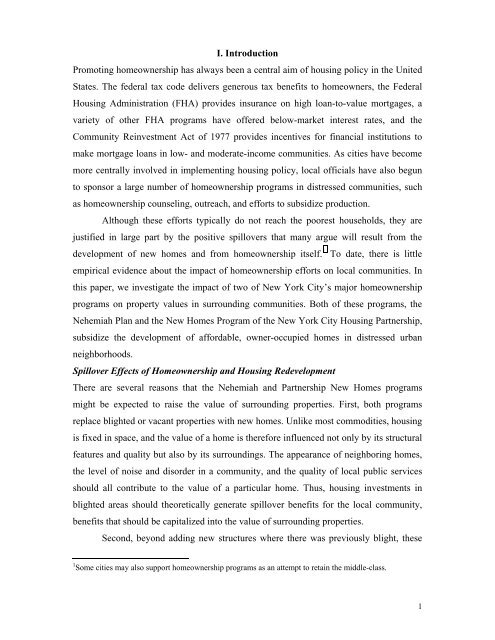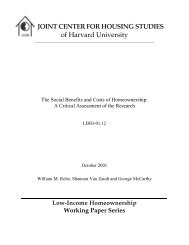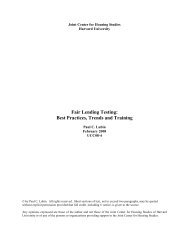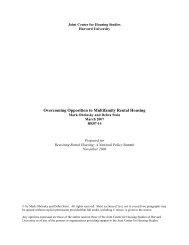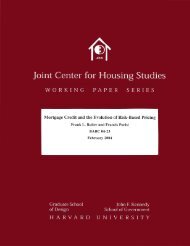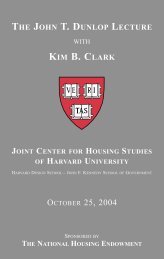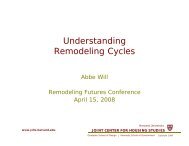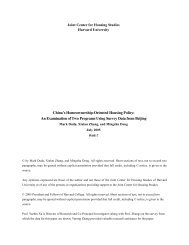please do not cite or circulate without permission of the authors
please do not cite or circulate without permission of the authors
please do not cite or circulate without permission of the authors
You also want an ePaper? Increase the reach of your titles
YUMPU automatically turns print PDFs into web optimized ePapers that Google loves.
I. Introduction<br />
Promoting homeownership has always been a central aim <strong>of</strong> housing policy in <strong>the</strong> United<br />
States. The federal tax code delivers generous tax benefits to homeowners, <strong>the</strong> Federal<br />
Housing Administration (FHA) provides insurance on high loan-to-value m<strong>or</strong>tgages, a<br />
variety <strong>of</strong> o<strong>the</strong>r FHA programs have <strong>of</strong>fered below-market interest rates, and <strong>the</strong><br />
Community Reinvestment Act <strong>of</strong> 1977 provides incentives f<strong>or</strong> financial institutions to<br />
make m<strong>or</strong>tgage loans in low- and moderate-income communities. As cities have become<br />
m<strong>or</strong>e centrally involved in implementing housing policy, local <strong>of</strong>ficials have also begun<br />
to spons<strong>or</strong> a large number <strong>of</strong> homeownership programs in distressed communities, such<br />
as homeownership counseling, outreach, and eff<strong>or</strong>ts to subsidize production.<br />
Although <strong>the</strong>se eff<strong>or</strong>ts typically <strong>do</strong> <strong>not</strong> reach <strong>the</strong> po<strong>or</strong>est households, <strong>the</strong>y are<br />
justified in large part by <strong>the</strong> positive spillovers that many argue will result from <strong>the</strong><br />
development <strong>of</strong> new homes and from homeownership itself. 1 To date, <strong>the</strong>re is little<br />
empirical evidence about <strong>the</strong> impact <strong>of</strong> homeownership eff<strong>or</strong>ts on local communities. In<br />
this paper, we investigate <strong>the</strong> impact <strong>of</strong> two <strong>of</strong> New Y<strong>or</strong>k City’s maj<strong>or</strong> homeownership<br />
programs on property values in surrounding communities. Both <strong>of</strong> <strong>the</strong>se programs, <strong>the</strong><br />
Nehemiah Plan and <strong>the</strong> New Homes Program <strong>of</strong> <strong>the</strong> New Y<strong>or</strong>k City Housing Partnership,<br />
subsidize <strong>the</strong> development <strong>of</strong> aff<strong>or</strong>dable, owner-occupied homes in distressed urban<br />
neighb<strong>or</strong>hoods.<br />
Spillover Effects <strong>of</strong> Homeownership and Housing Redevelopment<br />
There are several reasons that <strong>the</strong> Nehemiah and Partnership New Homes programs<br />
might be expected to raise <strong>the</strong> value <strong>of</strong> surrounding properties. First, both programs<br />
replace blighted <strong>or</strong> vacant properties with new homes. Unlike most commodities, housing<br />
is fixed in space, and <strong>the</strong> value <strong>of</strong> a home is <strong>the</strong>ref<strong>or</strong>e influenced <strong>not</strong> only by its structural<br />
features and quality but also by its surroundings. The appearance <strong>of</strong> neighb<strong>or</strong>ing homes,<br />
<strong>the</strong> level <strong>of</strong> noise and dis<strong>or</strong>der in a community, and <strong>the</strong> quality <strong>of</strong> local public services<br />
should all contribute to <strong>the</strong> value <strong>of</strong> a particular home. Thus, housing investments in<br />
blighted areas should <strong>the</strong><strong>or</strong>etically generate spillover benefits f<strong>or</strong> <strong>the</strong> local community,<br />
benefits that should be capitalized into <strong>the</strong> value <strong>of</strong> surrounding properties.<br />
Second, beyond adding new structures where <strong>the</strong>re was previously blight, <strong>the</strong>se<br />
1 Some cities may also supp<strong>or</strong>t homeownership programs as an attempt to retain <strong>the</strong> middle-class.<br />
1


